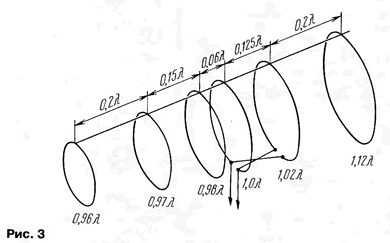Ham radio operators know how difficult it is to "bring" already made a television antenna to achieve the desired results. Required painstaking changing the geometry of the vibrators, careful selection of the distances between elements mnogovershinnoe design, conduct quite time consuming measurements (incidentally, many simply ignore them). Meanwhile the program MMANA allows you to do this in a matter of minutes. The effectiveness of the program solved had to check on the version already developed Amateur radio designs.
To this end, and to confirm the points made N. Turkina in his post "UHF Antenna" ("Radio", 2000, № 11, p. 9) described television the antenna was modeled using the program MMANA.
First of all, it was not difficult to establish that ordinary chastisement antenna "wave channel" ("Yagi UDA"), a few descriptions which; already in library programs provide the gain (amplification) to 11 G dB the isotropic radiator is in relation to the radiation of the forward/backward (F/B up to 20 dB. The disadvantage is small relative bandwidth is about 3...4 %, TTS can use them in the TV only as a single-channel antenna.
In the antenna N. Turkina used ring elements: three Directors; and reflector dual active, in which the rings are fed with a phase shift of 225°, providing additional focus and some extension of the strip.
Modeled accurately enough by the description, the antenna showed Ga and F/B accordingly 11,33 and 19.4 dB, i.e. the size of the same order as that of the normal chastisement wave channel. However, the bandwidth of its was much wider than it is about 7 % for VSWR<3 and about 14% according to the chart orientation (Ga and F/B > 10 dB). The direction diagram) simulated the antenna in the horizontal (top) and vertical planes for the Central the frequency is shown in Fig. 1, all values are in dB.
As rightly noted by the author, the antenna needs to be tuned. In the simulation this instructs the computer to automatically perform optimization program. To perform optimization. Optimized antenna showed a few more wins (11,63 dB), significantly better suppression back petal (24 dB), and bandwidth, VSWR and DN are normal (10 %), improved coordination with the feeder. NAM is shown in Fig. 2.

It is interesting to note that the graphs of the input impedance of the antenna curve jX (reactance) in the bandwidth three times crosses the zero the mark, which ensures good coordination. Design modified the antenna shown in Fig. 3. The perimeters of the elements and the distances between them are given in wavelengths.

The active element of the described antenna is exactly the same known hams radioamateurs design "Swiss double square" (in this case of the circle, but it's not so important), which gained popular. For the sake of interest in the description of the antennas were removed Directors and reflector. And what? Dual active element showed excellent results: Ga and F/B was 7.8 and 15.5 dB. Thus, given the complexity of manufacturing and get quality, he, perhaps, has no equal!
Author: V. Polyakov






